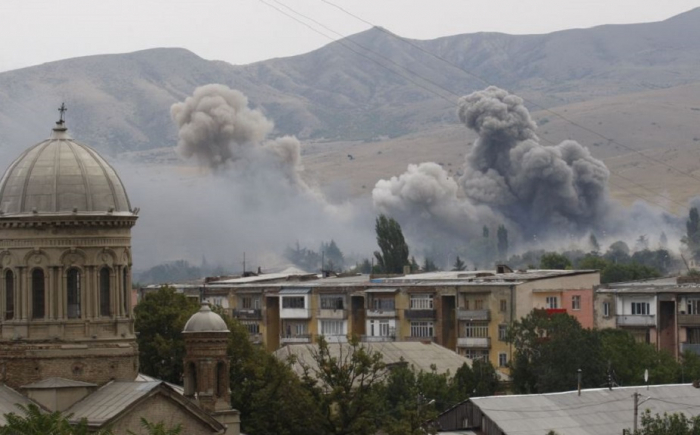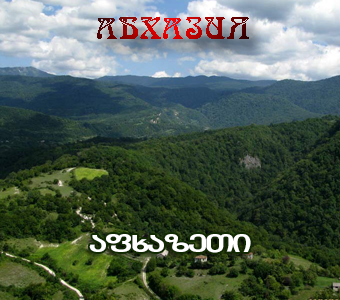ANALYTICS
08.08.20 12:15

August 8 marks the 12th anniversary of the start of Russia's aggression against Georgia in the Tskhinvali region and Abkhazia. The result of that aggression is hundreds of dead, destroyed infrastructure, wiped out Georgian villages, tens of thousands of refugees, occupation of 20% of the territory of Georgia.
In reality, the 80808 war did not begin in August 2008 or even in 1992, when the separatist war began in Abkhazia, which led to the massive ethnic cleansing of the Georgian population. In fact, the tragedy of Georgia began with the organization of separatist projects during the collapse of the USSR. The first of which was the "Artsakh" separatism initiated by the Armenian nationalists - the demand of the Armenian nationalists to separate Nagorno-Karabakh from Azerbaijan and annex it to Armenia.
It became clear from the very beginning that the matter would not end with Karabakh. After all, Elena Bonner (Alikhanyan) and her henpecked husband Andrei Sakharov, who were in favor of "miatsum" (annexation of Karabakh to Armenia), proposed a project for dismembering the union republics along the borders of autonomies and declared Georgia a “small empire” to be divided.
When the situation around Karabakh reached tension, the Armenian provocateurs deliberately provoked separatism in Abkhazia by organizing a "popular gathering" of separatists in the village of Lykhny. The anti-separatist movement of the Georgians ended in the bloody suppression of peaceful protests by the Soviet Army on April 9, 1989. Then, according to the same scheme, the "Black January" of 1990 was organized in Baku. The peoples protesting against separatism, at the suggestion of the initiators of the separatist projects, began to poison with gas and crush with tanks.
Separatism was kindled "according to the Karabakh scheme" in Tskhinvali as well. And the insidiousness of the provocateurs consisted in the fact that Russian troops were brought into the region as “peacekeepers”, which played their fatal role in the 2008 war.
Immediately after the "peacekeepers" settled in Tskhinvali, a war broke out in Abkhazia, in which the Armenian militants from the battalion named after. Baghramyan and other formations. The war ended with the ethnic cleansing of the Georgian population and the expulsion of over 300 thousand Georgians from their homes.
Most of Abkhazia and the Tskhinvali region with the help of the Russian army was torn away from Georgia even before 2008. But the separatist masters had to “consolidate” the redrawing of borders and ethnic cleansing and completely tear away from its ancestral lands from Georgia. For this, the 2008 war was organized, which began with the shelling of Georgian villages by separatists in the vicinity of Tskhinvali, and opposition to this genocide that had begun by the Georgian army became a pretext for aggression.
In the Tskhinvali region, a small Georgian army opposed a well-trained army of nuclear power. The aggressors faced stubborn resistance from Georgian soldiers. But the forces were not equal and the Georgian troops were forced to leave the Tskhinvali region.
Abkhazia, or rather the Kodori Gorge, again became the "second front" of the August 2008 war. Recall that here in 1993 the Svan militias repulsed the offensive of the many times superior forces of the separatists and the Armenian battalion named after Baghramyan. In 1994, the battalion. Baghramyan reinforced by militants transferred from the "Karabakh front" again tried to seize the Kodori Gorge, but was defeated after he managed to use the surprise factor to occupy the village of Lata. And finally, in August 2008, the entire power of the Russian military machine was brought down on the Svan militias and a small unit of the Georgian army in the Kodori Gorge of Abkhazia, as a result of which the occupation of this Georgian land took place.
Almost the entire Georgian population was expelled from their homes (out of 5 thousand inhabitants of the Georgian-Svan gorge, the occupants allowed only about a hundred people to stay - mostly helpless old people) and Kodori was, in fact, turned into a deserted gorge.
The courage of the Georgian army, which rebuffed the aggressors and separatists, and the solidarity of the world community with Georgia made it possible to stop the aggression. The Russian Federation, through the mediation of French President Nicolas Sarkozy, signed an agreement pledging to withdraw its troops from Georgia. But the Russian side immediately violated the agreement, not only maintaining the occupation of Abkhazia and the Tskhinvali region but recognizing their "independence". And it immediately became clear who was behind the aggression: most of all, the Armenian nationalist Sergei Lavrov-Kalantarov, the head of the Russian Foreign Ministry, was involved in the legalization of the separatists' "independence".
The threat of new aggression has not disappeared. The same forces that organized the genocide of Georgians in Abkhazia are kindling new centers of separatism in the South Caucasus. In Georgia, the most explosive region is Samtskhe-Javakheti.
KavkazPlus
Read: 415
Write comment
(In their comments, readers should avoid expressing religious, racial and national discrimination, not use offensive and derogatory expressions, as well as appeals that are contrary to the law)
News feed
-
Irakli Kobakhidze: These resolutions were worthless then and they have no value now
18:0326.04.24
-
Special Investigation Service exposes employee of Ministry of Internal Affairs to coercion
17:1126.04.24
-
16:3026.04.24
-
Irakli Kobakhidze: Non-transparent NGOs have tried to organize a revolution twice in this country
15:4526.04.24
-
15:0026.04.24
-
GeoStat: The number of emigrants increased by 95.6% in 2023
14:0726.04.24
-
Shalva Papuashvili: Visa liberalization will not be canceled
13:3626.04.24
-
Turkey is extending a hand of reconciliation to Armenia. Yerevan must seize opportunities
12:4326.04.24
-
11:5226.04.24
-
10:0026.04.24
-
From 'alliance' to open hostility: Armenia and Russia
19:0325.04.24
-
17:5425.04.24
-
17:0025.04.24
-
Lithuanian Ambassador: Foreign influence bill contradicts EU recommendations
16:1025.04.24
-
Shalva Papuashvili: We hear statements and concerns from the US State Department, Brussels
15:3025.04.24
-
14:5725.04.24
-
14:0625.04.24
-
13:1425.04.24
-
Defense Committee Chair hosts Head of NATO Liaison Office in Georgia
12:3025.04.24
-
11:5725.04.24
-
11:1125.04.24
-
Rally against draft law "On Transparency of Foreign Influence" underway near Parliament
10:0025.04.24
-
MIA to identify individuals calling for blocking roads artificially during Rustaveli Avenue rallies
18:0024.04.24
-
Lazare Grigoriadis leaves prison
17:3024.04.24
-
Irakli Kobakhidze to participate in the Conservative Political Action Conference in Hungary
17:0024.04.24
-
16:1724.04.24
-
15:3024.04.24
-
Youth social entrepreneurship support project kicks off
14:5024.04.24
-
14:0024.04.24
-
Tbilisi Mayor deems new stadium construction as a mega project
13:2024.04.24
-
12:2424.04.24
-
Rustavi City Council Chairman dismissed
11:3024.04.24
-
10:2224.04.24
-
9:0024.04.24
-
Tusheti Protected Landscape in Georgia’s north-east to expand by 2,245 hectares
18:0023.04.24
-
17:2823.04.24


